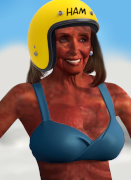|
SupSuper posted:If only MSVC had full C++11 support. I'm pretty sure that was one of the first things they supported, well before the standard was finalized.
|
|
|
|

|
| # ? May 26, 2024 19:15 |
|
seiken posted:When you say you just keep an integer index into an array of matrices, you mean the array is in the shader so you don't have to switch state, right? I'm still pretty sure you shouldn't need to batch by view transformation. This is how I use it: 1. Each 'section' has a 'view', which translates to a 4x4 Matrix. 2. The 'game' has a list of N 'sections'. A section is really a scene. Typical scenario is that Section 1 is a level that's scrolling away, Section 2 is a level that's scrolling in, Section 3 is the HUD. 3. The gather-render-items method loops over the sections. For each section, it calculates the 4x4 view matrix and assigns an index to it. It sets up the 'batcher' (the wrapper around my big dictionary) such that all subsequent 'add item' calls will use that number (0, 1, or 2) as the view index. The reason it's done this way instead of building N separate lists is because the 'view dictionary' isn't the top level dictionary. 4. So, the first section is rendered with view matrix 0, the second section is rendered with view matrix 1, etc. I really like your idea of eliminating the extra batches by view! The only downside is that I'd have to send an extra byte (depending on how many views I want to support at once, I'm sure 256 is reasonable enough...) to the GPU per vertex. Manslaughter posted:Is there a reason you can't use a ref Matrix4?
|
|
|
|
Orzo posted:I really like your idea of eliminating the extra batches by view! The only downside is that I'd have to send an extra byte (depending on how many views I want to support at once, I'm sure 256 is reasonable enough...) to the GPU per vertex. I'm by no means a graphics expert, but I think this is probably worth it. As I understand it state switches are ridiculously more expensive than anything else so it's worth eliminating them at pretty much any cost (plus a byte per vertex is basically nothing!)
|
|
|
|
But what am I going to do if I need to render 257 scenes at once?!?!?
|
|
|
|
As someone told me in the Graphics Questions thread, it's best to profile your code with AMD/NVidia's tools before making assumptions about what's faster than what. Graphics drivers do all sorts of runtime optimizations. An extra uniform parameter change might stall the graphics pipeline, or it may not, less/more than a texture change. An extra byte attribute might cause your vertex data to lose favourable alignment in GPU memory, or if padded to alignment, cause bigger vertices and thus worse cache performance. And on top of that, none of this might matter at all unless you start dealing with tens of thousands of things to render per frame. Keep your code simple to write and debug at first, then profile and optimize later.
|
|
|
|
That Turkey Story posted:I'm pretty sure that was one of the first things they supported, well before the standard was finalized.
|
|
|
|
SupSuper posted:The keyword is full support: http://msdn.microsoft.com/en-us/library/vstudio/hh567368.aspx Yeah, I know. The chances of Microsoft ever fully supporting C++98, let alone C++11 are pretty slim, despite their more recent claims.
|
|
|
|
That Turkey Story posted:Yeah, I know. The chances of Microsoft ever fully supporting C++98, let alone C++11 are pretty slim, despite their more recent claims. The CTP gets it fairly close. But still lacks constexpr and some other things, really hurts.
|
|
|
|
All I can say is, do whatever works for you in your personal projects, but declaring nested containers would be a spectacularly quick way of failing a programming test at most studios. And asking why you shouldn't do that would probably be a pretty good interview question...
|
|
|
|
I'm curious to hear your reasons. I'm guessing it has something to do with the cache performance compared to a flat array. All I know is that when done correctly, the performance hit in the nested dictionaries is not even close to the performance bottleneck.
|
|
|
|
Orzo posted:I'm curious to hear your reasons. I'm guessing it has something to do with the cache performance compared to a flat array. All I know is that when done correctly, the performance hit in the nested dictionaries is not even close to the performance bottleneck. Cache performance and memory fragmentation issues (depending on the implementation details). There's usually a better way, even if it makes the initial implementation more complex. EDIT: In your previous example, I'd be willing to bet that the O(n log n) hit of a per-frame in-place sort of a flat array would be faster than nested dictionaries. Vinterstum fucked around with this message at 02:42 on May 30, 2013 |
|
|
|
Orzo posted:Just about every 2D graphics engine has some sort of layering and batching system to minimize state changes on the GPU. In my case, a state change is either (a) a texture change, (b) a blending mode change, or (c) a view transform change (I perform my view matrix calculations on the GPU and use a uniform for the matrix). What does "batch" and "batching system" mean? I think I've scene it in the Infiniminer source in regards to 2D sprites, but I'd like to know more.
|
|
|
|
Vinterstum posted:Cache performance and memory fragmentation issues (depending on the implementation details). There's usually a better way, even if it makes the initial implementation more complex. KoRMaK posted:This just gave me insight into yet another way the principal of "states" can be applied. Batching is the reason why people create Texture Atlases, also sometimes known as sprite sheets. If we put the apple and orange, two 64x64 images, into one 128x64 image, then we can draw the ENTIRE set of things without any switches at all. http://en.wikipedia.org/wiki/Texture_atlas Switching textures isn't the only thing that's expensive. Changing blend modes, texture filtering modes, setting variables (uniforms) on shaders, etc, are all things that are 'expensive'.
|
|
|
|
Oh so batching can go beyond just 2D applications. Say, a "glass" polygon with transparency, or even polygons of different textures. Is that also a reason in the pro column to use sprite sheets instead of animated gifs? I've never scene an efficiency reason or otherwise for why to use one over the other. I prefer gifs.
|
|
|
|
Yes, batching has nothing to do with 2D. The same techniques apply to 3D, too. GIFs are a pain in the rear end to manage, IMO. Any image editor or content pipeline worth using will have *some* way to visualize many frames--say, bmp or png--in a way that you might with a gif.
|
|
|
|
Orzo posted:GIFs are a pain in the rear end to manage, IMO. Any image editor or content pipeline worth using will have *some* way to visualize many frames--say, bmp or png--in a way that you might with a gif.
|
|
|
|
KoRMaK posted:Is that also a reason in the pro column to use sprite sheets instead of animated gifs? I've never scene an efficiency reason or otherwise for why to use one over the other. I prefer gifs. Besides the benefit that spritesheets will give you batching in engines that draw 2d sprites as polygons, with gifs you are going to be limiting yourself to a 256 color palette per animation and the accompanying dithering associated with turning an image into that palette. Besides that, not many frameworks will let you load up a gif and play it within the context of a game, that I know of? Are you using the gif timing for the animation timing, or timing it out yourself? I actually can't think of any benefit to using animated gifs. There are many utilities out there that will take a series of images done in photoshop and pack them into an easily parseable atlas for your platform of choice - like http://www.codeandweb.com/texturepacker
|
|
|
|
KoRMaK posted:Meaning that while I'm working on a sprite sheet, I can quickly see what it would look like run together as an animation? What image editor is good for this? I'm using Photoshop and don't know of a feature that does this, except for the gif style animation stuff. When I make sprite animations in Photoshop I'll grid off an area with guidelines (click the ruler and drag to where you want it to be) to create squares of my desired dimensions. When I animate I'll create and edit duplicate layers (ctrl+J copies a selection to a new layer and ctrl+shift+J cuts to a new layer) to save time, but I'll always keep the frame layers on top of each other in the same grid, this way I can open up the Animation window and run test cycles to see how fluid it is or what needs to be changed (I prefer Filmstrip mode to Timeline mode for Photoshop animation). Only after all the frames are done and fluid will I drag them over to separate squares in my grid to flatten out into a sprite sheet. You can also work on your frames side-by-side to rough them out- and in spite of what I just typed I'll sometimes do this- but when you start finalizing you'll want the layers positioned overtop one another so you can see how they cycle within the same sprite space. Working on separate layers is crucial so you don't have to keep importing sprite sheets into a game to see where your animation mistakes might be, and you can always flatten them out and re-separate them with ctrl+shift+J as needed.
|
|
|
|
Vinterstum posted:Cache performance and memory fragmentation issues (depending on the implementation details). There's usually a better way, even if it makes the initial implementation more complex. ... though it definitely makes me cringe, regardless, for the aforementioned reasons.
|
|
|
|
Orzo posted:
If you're iterating over everything in your dictionaries, it's almost certainly going to be faster to do it more like this (innermost dictionary only): code:Edit: I'm dumb, indexing into a Dictionary is O(1) ninjeff fucked around with this message at 09:47 on May 30, 2013 |
|
|
|
I made a particle system in Unity using the legacy particle system (I'm following a tutorial). However, the particle system is just magenta squares, and I can't set a color. What's going wrong here?
|
|
|
|
I use a lot of hardware instancing and have to batch my renderables by what model they're an instance of, then by texture atlas. For example the leaves in my trees are just a quad with a texure but can't be batched together with any other 'billboard sprites' because they don't share the same group of textures. I'm having major alpha channel / sprite sorting issues though as you can see in these trees:  ninjeff posted:Edit: I'm dumb, indexing into a Dictionary is O(1) Nevermind I just looked it up, I thought dictionary lookups were log n.. Mata fucked around with this message at 18:20 on May 30, 2013 |
|
|
|
the posted:I made a particle system in Unity using the legacy particle system (I'm following a tutorial). However, the particle system is just magenta squares, and I can't set a color. What's going wrong here? Are you using your own texture for it? If so, make sure to set the materials shader or whatever to 'Particles/...'. 
|
|
|
|
Stiggs posted:Are you using your own texture for it? If so, make sure to set the materials shader or whatever to 'Particles/...'. Um... I'm not sure how to get that? I have been following this video, and someone earlier in this thread said to make what he has I need to make an empty gameobject and add in Ellipsoid Particle Emitter, Particle Renderer, and Particle Animator. I did that, and I have the same animation as him now, but my particles look like giant magenta squares and changing the colors in the Particle Animator window does nothing. EDIT: I've gotten it to be "not magenta" by going into the Particle Renderer --> Materials --> Element 0 and selecting "Default-Particle" which gives me some block shapes, but those still aren't colored by the Particle Animator tab. EDIT: Wait, it worked! the fucked around with this message at 21:10 on May 30, 2013 |
|
|
|
Shalinor posted:This is all true, and it also basically doesn't matter for most use cases. All the usual arguments against premature optimization apply. If his crazy nested classes work, then that makes sense, until it actually presents a bottleneck. Makes for a good interview question though!
|
|
|
|
I just realized tomorrow is June 1st and I haven't seen a thread about another SA Game Dev Challenge. Are they over and done with?
|
|
|
|
Dr. Dos posted:I just realized tomorrow is June 1st and I haven't seen a thread about another SA Game Dev Challenge. Are they over and done with? Tomorrow is May 31st in the US.
|
|
|
|
I'm doing some self-teaching on game coding over the summer. I recently read this article about how a puzzle game developer made an interesting system for viewing the state space of a puzzle. What would be the best language for whipping something like that up? Basically something capable of gui features and simple, manipulable graphics.
|
|
|
|
HTML5 would be good for that, but probably not so hot on the "usefully save/load" aspect of things. (I knocked up a "convert database schema file into well arranged graph diagram with additional information mouseovers" thing in a couple of hours, probably quicker than it would have been to just draw the diagram by hand. HTML5 is great for diagram-type output because the canvas has all the line functions and poo poo that you used to get in basic languages, with hardly any of the setup poo poo you have to do for your opengl, directx or windowing-system-API.)
roomforthetuna fucked around with this message at 02:22 on May 31, 2013 |
|
|
|
This is AS3/Flixel. I'm trying to load an array for a tile map from an external file. Eventually I'm hoping to combine this with some PHP scripting for a very basic online level editor, but for now I'm just working locally. code:It may just be because it's almost 4am but I'm lost as to how I can wait until that handler finishes before returning anything in the outer method...
|
|
|
|
A Bloody Crowbar posted:This is AS3/Flixel. Yeah, you're returning the null data object instantly because the load hasn't completed by the time the function ends. The onLoad event hasn't fired yet. Flash isn't threaded so you can't like, force a wait in that function until it's done or the whole program will halt waiting for the load. Do this instead: code:
|
|
|
|
If you need useful save/load for an HTML5 app, node-webkit is a good option. You could then use the node.js filesystem functions.
|
|
|
|
I am struggling with collision detection in my little 2d tile based game.  I didn't really know where to begin, so I looked at the Platformer starter kit for XNA and pretty much just used that. And it works, but there is a point in between the tiles where if you land there, the thing that is colliding with that tile snaps 8 or so pixels to the right. That was a terrible explanation, so here's a video! https://www.youtube.com/watch?v=X78-Os_A5_8 This is the 'RectExtension' class. code:code:Or if this is a bad way of handling collisions, I'd be happy to hear suggestions for other methods!
|
|
|
|
Before giving up, I highly recommend figuring out a way to set a breakpoint at the moment of the first collision after jumping and then stepping through your process from there. C#/Visual Studio has excellent debugging functionality, learning to use effectively is critical. In case you're not familiar, here's a quick crash course: 1. Set a breakpoint on any line with F9, or by clicking the bar to the left of your code. 2. Right click the breakpoint and set a condition. 2a. Alternatively, because (2) can be slow, I just a block of code to the place I'd normally do (2): code:4. Hover over variables or use the locals window to look at stuff. Use the immediate window to type in whatever the hell you want--either to print out values of local variables or execute commands. Orzo fucked around with this message at 15:47 on May 31, 2013 |
|
|
|
Orzo posted:Before giving up, I highly recommend figuring out a way to set a breakpoint at the moment of the first collision after jumping and then stepping through your process from there. C#/Visual Studio has excellent debugging functionality, learning to use effectively is critical. Thanks, what seems to be happening is that it is still colliding with the tile to the left and the X intersection is smaller than the Y intersection on that tile, so it pushes it along the X axis instead of the Y. Now to figure out how to actually fix it. 
|
|
|
|
Stiggs posted:Now to figure out how to actually fix it. And if there's a tile in both directions then 'this tile' doesn't need to do anything at all because both of those tiles will be pushing the player out (unless you've got your steps way too big).
|
|
|
|
Having gone down this road more than once, I highly recommend you start breaking your already small methods into even smaller methods and start commenting liberally. This will keep you from tearing your hair out in frustration from tiny "what ifs" as they spring up as well as prevent the "deer in the headlights" look when you come back a week later and see nothing but X and Y everywhere and no idea how it all came to be.
|
|
|
|
Thanks guys, I've got it working a little better now. Before it was looping through every tile that it was touching, so when you were in between two tiles it was still getting the intersect depth of the tile to the bottom left of the player, so when the X intersect of the bottom left tile was small enough, it just pushed you to the right. I've changed it so that it will only push you along the X axis if there are tiles directly to the left or directly to the right. This fixed the issue I was originally having, but now the same sort of thing is happening when you hit a tile from the bottom while jumping into it. One step at a time!  poemdexter posted:Having gone down this road more than once, I highly recommend you start breaking your already small methods into even smaller methods and start commenting liberally. This will keep you from tearing your hair out in frustration from tiny "what ifs" as they spring up as well as prevent the "deer in the headlights" look when you come back a week later and see nothing but X and Y everywhere and no idea how it all came to be. Yeah I definitely need to get better at commenting my code. I will keep this in mind.
|
|
|
|
Stiggs posted:I've changed it so that it will only push you along the X axis if there are tiles directly to the left or directly to the right. What I meant was check like code:Obviously this shouldn't just be right and up, it should be whatever direction X and Y adjustments, and the blocked-check should be adjusted to the appropriate directions, this is just the concept. Edit: Also, x and y in this pseudocode are the tile coordinates, not the pixel coordinates. roomforthetuna fucked around with this message at 20:37 on May 31, 2013 |
|
|
|

|
| # ? May 26, 2024 19:15 |
|
Here's a nonportable way I use to generate temporary breakpoints, that works only on x86:code:
|
|
|































